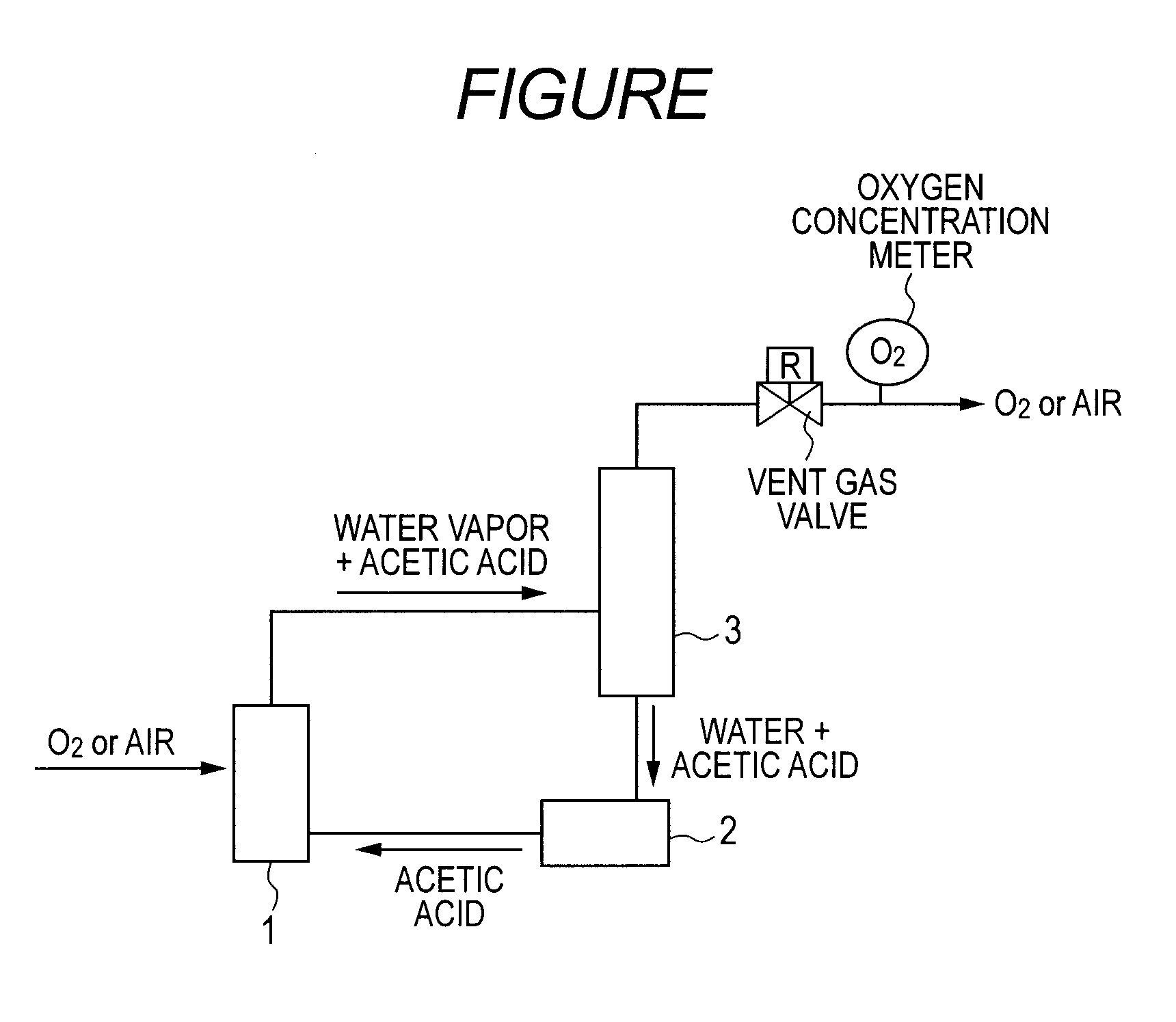Method of producing 2,5-furandicarboxylic acid
a technology of furandicarboxylic acid and pyridoxine, which is applied in the field of method of producing 2, 5furandicarboxylic acid, can solve the problems of difficult to achieve the increase of raw material concentration with a conventionally known technology, and achieve the effects of high yield, high purity and high yield
- Summary
- Abstract
- Description
- Claims
- Application Information
AI Technical Summary
Benefits of technology
Problems solved by technology
Method used
Image
Examples
example 1
[0035]A catalyst-suspended aqueous solution prepared by weighing 45.5 ml of acetic acid, 4.8 g of 5-HMF, 0.10 g of cobalt acetate tetrahydrate, 0.32 g of manganese acetate tetrahydrate, and 0.010 g of sodium bromide was charged into the reaction vessel 1 (see FIGURE) provided with a stirring machine. In addition, the reaction vessel 1 was provided with a trap of 30 g of a Molecular Sieve (4A) manufactured by KISHIDA CHEMICAL Co., Ltd. as a water content regulator.
[0036]The prepared catalyst-suspended aqueous solution was stirred at 25° C. for 1 hour while air was introduced under a pressure of 0.3 MPa. After that, the temperature was increased to 150° C., and then stirring was performed for 1 hour in order that water might be sufficiently adsorbed by the dehydration agent of the trap. After that, the pressure was increased to 3 MPa, and then stirring was performed for 1 hour. Next, the temperature was reduced to 25° C., and then the product was taken out.
[0037]The product that had b...
example 2
[0038]A catalyst-suspended aqueous solution was prepared in the same manner as in Example 1 by weighing the same amounts of the samples as those of Example 1. The prepared catalyst-suspended aqueous solution was stirred at 25° C. for 1 hour while oxygen was introduced under a pressure of 0.3 MPa. After that, the temperature was increased to 150° C., and then stirring was performed for 2 hours while water was removed. Next, the temperature was reduced to 25° C., and then the product was taken out.
[0039]After the reaction, the same analysis as that of Example 1 was performed. As a result, the yield of FDCA was 73.4% and a water content was 1.03%.
example 3
[0040]A catalyst-suspended aqueous solution was prepared in the same manner as in Example 1 by weighing the same amounts of the samples as those of Example 1. The prepared catalyst-suspended aqueous solution was stirred at 25° C. for 1 hour while oxygen was introduced under a pressure of 0.3 MPa. After that, the temperature was increased to 150° C., and then stirring was performed for 2 hours. Next, the temperature was reduced to 25° C., and then the product was taken out.
[0041]After the reaction, the same analysis as that of Example 1 was performed. As a result, the yield of FDCA was 65.7% and a water content was 1.31%.
PUM
| Property | Measurement | Unit |
|---|---|---|
| pressure | aaaaa | aaaaa |
| pressure | aaaaa | aaaaa |
| temperature | aaaaa | aaaaa |
Abstract
Description
Claims
Application Information
 Login to View More
Login to View More - R&D
- Intellectual Property
- Life Sciences
- Materials
- Tech Scout
- Unparalleled Data Quality
- Higher Quality Content
- 60% Fewer Hallucinations
Browse by: Latest US Patents, China's latest patents, Technical Efficacy Thesaurus, Application Domain, Technology Topic, Popular Technical Reports.
© 2025 PatSnap. All rights reserved.Legal|Privacy policy|Modern Slavery Act Transparency Statement|Sitemap|About US| Contact US: help@patsnap.com

